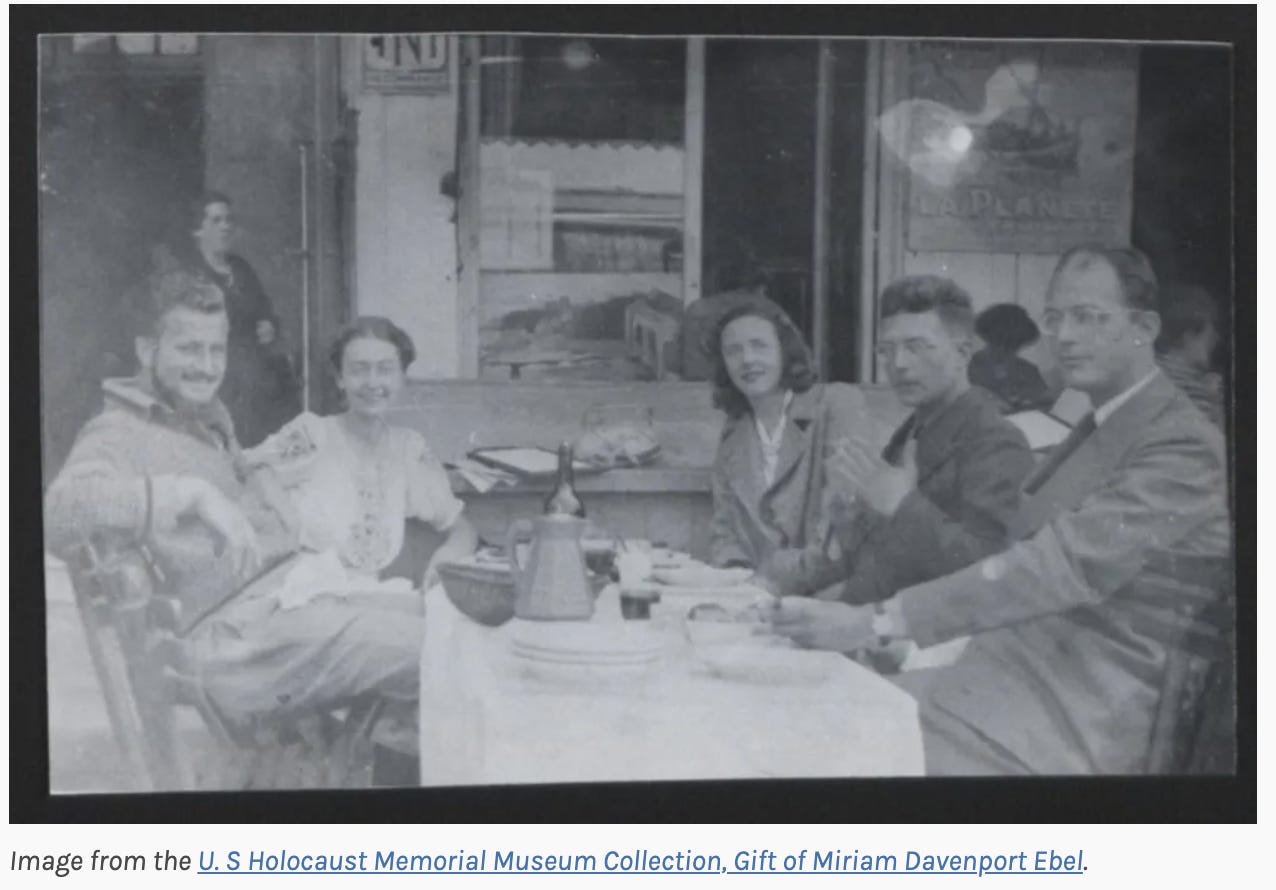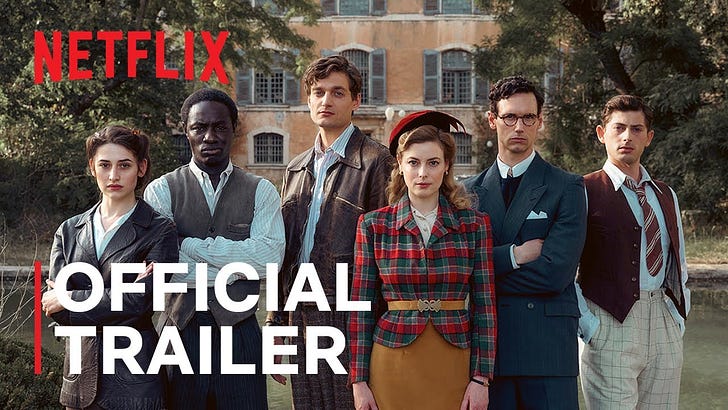Shining a light on Varian Fry, one of WW2's "Righteous," and America's lack of intervention to save Jews and anti-Nazis in early 1940s Europe
Netflix's "Transatlantic" takes fictional liberties with its telling of Fry's ERC and the feats he and Mary Jayne Gold went thru to save Jews and other intellectuals in Vichy-occupied France.
In Making Transatlantic, the 30 minute BTS (behind-the-scenes) on the newly dropped Netflix limited series, Transatlantic, the show’s creator, Anna Winger (Unorthodox) summarizes the courageous actions of the Emergency Rescue Committee (ERC), a humanitarian relief agency founded in the 1940 to rescue persecuted artists and politicians from France to the United States and the subject of the show:
In the end, the ERC got more than 2000 people out of Europe. Some might see that as a drop in the bucket but even a small act of kindness and bravery on this scale can have an enormous impact on the world and other people’s lives.
So I feel like American intellectual life was changed permanently, and mid-century modern artistic expression in America was permanently impacted by the artists who came over…
Most Profoundly Dark Event in 20th Century History and possibly my lifetime (I hope)
In this made-for-compelling Netflix TV version, we get a fictionalized account based on the real-life operation of a small, but mighty group of American and German humanitarians, like Varian Fry and Mary Jayne Gold, who worked against the Vichy regime (Nazi collaborators regime in France) to smuggle Jewish and anti-Nazi intellectuals and artists out of Marseilles - among them the artist Marc Chagall, writer Hannah Arendt, Nobel Prize winner, physician, and biochemist Otto Meyerhoff, writer Walter Mehring, sculptor Jacques Lipchitz, artist Max Ernst, and the family of writer Thomas Mann - between 1940 and 1941.
In addition to the ERC, allies in working against the Vichy and Nazi regimes, included the British and an underground network of spies from France, Germany and the U.S. so lots of espionage. In your knowledge of U.S. history, you may recall that Franklin Roosevelt resisted at all costs getting the American government involved in WW2 and only as a 3rd term president, did he finally intervene and only once the Pearl Harbor attack happened (December 1941), which was instigated by Japan, Germany’s Axis ally.
To reflect the isolationist stance, the show portrays via the fictionalized character of a U.S. diplomat in Marseilles, called Patterson (House of Cards’, Corey Stoll, in a role ripe for the versatile actor who can do smarmy quite well), that the U.S. made nice with Vichy, and recognized them formally, in a desire to keep the peace with the Nazis. That said, the show features a real-life character, Hiram Bingham, who acted, as U.S. Vice Counsel in France and aided Fry in issuing entry visas to the USA. Once his actions were realized, he was demoted by the U.S., likely for his work in support of the ERC and sent to Argentina, where you may recall, many Nazi criminals escaped to. As a side note, the most famous Nazi war criminal who escaped to Argentina being Eichmann who was eventually captured and stood trial for his crimes. Coincidentally, Hannah Arendt, one of the jews saved by ERC, eventually went on to write a very well-reputed book, “Eichmann in Jerusalem: A Report on the Banality of Evil” about the trial.

Bingham, eventually retired from the foreign service, only to be honored later in life.

The act that ignited Fry’s dedication to humanitarian efforts during WW2
“I saw one [Jewish] man brutally kicked and spat upon as he lay on the sidewalk, a woman bleeding, a man whose head was covered with blood, hysterical women crying. . . . Nowhere did the police seem to make any effort whatever to save the victims from this brutality.”
Varian Fry, upon witnessing this act while working as a foreign correspondent in Berlin in 1935, 5 years before he led the ERC in rescuing over 2000 people from Marseille.
Furthermore, he added in 1945:
"I could not remain idle as long as I had any chances at all of saving even a few of its intended victims.”
Mary Jayne Gold, an American heiress, whose monetary contributions were vital to the ERC’s continued existence also used her skills (brains, beauty, and vision) to capitalize on how people would underestimate her as a female, to successfully land spy missions, i.e. leading the rescue of prisoners from a concentration camp. The show leaves out a real-life critical piece of the ERC operation which was American artist Miriam Davenport, a friend of Gold’s with whom she arrived in Marseille and overheard about Fry’s presence in the city and what he was doing, and decided to work hand-in-hand with Fry. Without the well-organized and well-connected Davenport, it’s probable that ERC wouldn’t have been as successful.

As an American Jew who is pretty well-versed in Holocaust history and WW2, I was surprised I knew nothing of Fry and the work he did in partnership with Gold, who subsidized the ERC’s rescue system, before watching this show. Now that I do, I’ve been a sponge for facts on the two of them and how much of the show’s characters were based on real people. So far, apart from Fry, Bingham, and Gold, the other real-life characters, who are portrayed on the show, are Hans and Lisa Fittko, resistance fighters who were responsible for smuggling people through the Pyrenees. If you come across any others that I’ve missed in my recount here, please share.
The Legacy of all this
At Yad Vashem, the World Holocaust Remembrance Center, in Israel, close to 30K people have been honored as “The Righteous” - among these, Varian Fry is one. The Righteous are non-Jewish people who risked their own lives to save Jews during the Holocaust. For a more exhaustive list of criteria required to receive this honor, see here.
In anticipation of Yom HaShoah, the annual day of Holocaust Remembrance, on Monday, April 17th, the timing of this show’s release bears some significance. It’s my hope that people will learn from shows like this about this period in history and remember those that did what they could to protect the sanctity of human life against evil.
The show’s creator Anna Winger’s mission in telling this beautiful, vibrant, heroic story offered up in Transatlantic, is to bring stories of exceptional bravery and everyday people doing extraordinary things within the context of this time period to the surface.
“The people who lived through these stories are dying out,” she told the Jewish Telegraphic Agency. “My job is to bring this to a wide audience, to people who don’t know anything about it.”
As I’m currently in Israel, a country whose existence as a Jewish homeland was necessitated by the atrocities and genocide of 6 Million+ European Jews in WW2 (2000 of which were spared by ERC’s actions) not to mention the everyday oppression of Jews happening all over the world in countries that barely tolerated Jewish people, I feel particularly close to this story and what it represents, especially as this nation is currently struggling with the acts of a government who is seeking to make significant changes to the high court. The lack of checks and balances threaten the foundation of socialist ideals on which the state of Israel was founded. And Israel must remain a safe haven for Jews, protecting its people, lest we have another genocide with no state for the Jewish people to return to.
But is it worth seeing Transatlantic?
If, like me, you love to go down nerd holes (see below) about WW2 or just generally any part of history, then yes, watch this. If you are interested in how Jewish artists, like Chagall and Max Ernst found their way to safety, watch it. Watch it for the somewhat contrived romances and the more serious and heart-wrenching thread of how refugees who were losing so much, could come together to form a community of joy and celebration, despite their circumstance or perhaps, because of them.
Watch it because as Winger alludes to with the passing of those who experienced the Holocaust, those stories and what happened also fade, and we should never forget them.
Was the show the best way to burn ~420 minutes of my life? In parts, especially at the beginning of the series, dialogue and acting felt a bit stale and mechanical but then the Wes Anderson feels of the absurd with the comedic bent in an otherwise hopeless situation kicked in, and the series found a rhythm. Plus, the story writes itself and the costume design is so much fun.
I don’t know that this show is the best fit for Gillian Jacobs (Mary Jayne Gold). Her facial expressions felt more 2000s than 1940s, which I know may sound unfair to state, but I noticed it more in her than in other characters. In her defense, t could have been the editing. I think Jacobs is a talented actress but I’ve enjoyed her more in shows like Love that showcase her ability to be both dramatic and funny. That said, she can hold it together enough for the show to work and that’s clutch because apart from Cory Michael Smith’s young Varian Fry, she is the glue.

From the “Truth is More Interesting than Fiction” Archives
Interesting Facts shared on Ynet:
The real Varian Fry, a 32-year-old journalist and suit-clad Harvard graduate, showed up in Marseille with $3,000 taped to his leg and a list of 200 names in August 1940.
After France surrendered to Germany, Fry was among 200 Americans — including journalists, artists, museum curators, university presidents and Jewish refugees — to create the Emergency Rescue Committee at the Hotel Commodore in New York. This group was concerned with Article 19 in France’s armistice with Germany, which required French authorities to surrender any individuals demanded by the Germans.
The private relief organization drew up frenzied lists of anti-Nazi intellectuals who were trapped in France. With the help of first lady Eleanor Roosevelt, the ERC obtained some emergency visas and sent Fry to lead the rescue efforts in Marseille, a port city in the southern, unoccupied part of France.
And go see this show with Gillian Jacobs if you want to see her in her element, but also see Transatlantic, for all the reasons I cited above.





